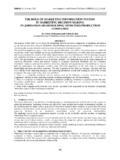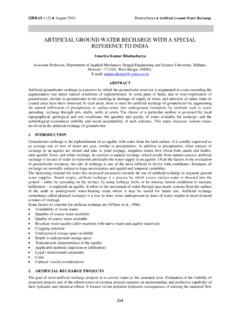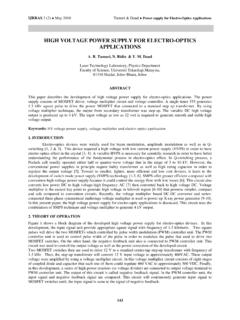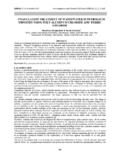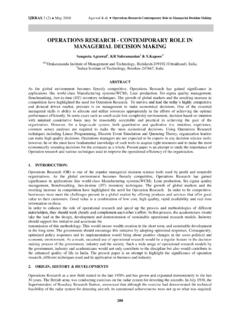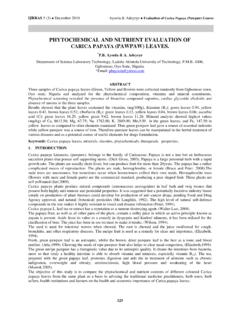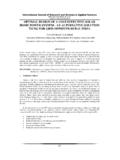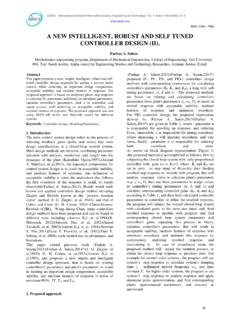Transcription of LOSSES IN ELECTRICAL POWER SYSTEM - …
1 IJRRAS 12 (2) August 2012 320 ANALYSIS OF TECHNICAL LOSSES IN ELECTRICAL POWER SYSTEM (NIGERIAN 330KV NETWORK AS A CASE STUDY) M. C. Anumaka Department Of ELECTRICAL Electronic Engineering, Faculty of Engineering, Imo State University, Owerri, Imo State, Nigeria Email: ABSTRACT In recent year, electric POWER demand has increased drastically due to superiority of electric energy to all other forms of energy and the expansion of POWER generation and transmission has been severely limited sequel to limited resources, environmental restrictions and lack of privatization as can be found in the developing countries of the world like Nigeria, Togo, India, etc. No matter how the POWER SYSTEM is designed, LOSSES are unavoidable and must be modeled before accurate representation can be calculated.
2 This paper focuses on the mathematical analysis of LOSSES that occur in electric POWER SYSTEM . The Depezo loss formula, loss factor, use of SYSTEM parameters for evaluating the SYSTEM LOSSES , the differential POWER loss and POWER flow methods are explicitly illustrated. The B- LOSSES coefficient, which expresses the transmission LOSSES as a function of outputs of all generation, is also explained. Keywords: Dopazo Formula, B- LOSSES co-efficient, SYSTEM parameters, Loss factor. 1. INTRODUCTION The Nigerian POWER SYSTEM network, like all other POWER SYSTEM , waves about the entire country and it is by far the largest interconnection of a dynamic SYSTEM in existence to date. No matter how carefully the SYSTEM is designed, LOSSES are present. Electric POWER LOSSES are wasteful energy caused by external factors or internal factors, and energy dissipated in the SYSTEM [6, 8, 10].
3 They include LOSSES due to resistance, atmospheric conditions, theft, miscalculations, etc, and LOSSES incurred between sources of supply to load centre (or consumers). Loss minimization and quantification is very vital in all human endeavour. In POWER SYSTEM , it can lead to more economic operation of the SYSTEM . If we know how the LOSSES occur, we can take steps to limit and minimize the LOSSES . Consequently, this will lead to effective and efficient operation of the SYSTEM . Therefore, the existing POWER generation and transmission can be effectively used without having the need to build new installations and at the same time save cost of LOSSES . Basically, LOSSES in ELECTRICAL POWER SYSTEM can be identified as those LOSSES caused by internal factors known as Technical LOSSES and those cause by external factors are called non-technical LOSSES .
4 The Nigerian electricity grid has a large proportion of transmission and distribution LOSSES - whopping 40%. This is attributed to technical LOSSES and non-technical LOSSES . Due to the size of the area the POWER SYSTEM serves, the majority of the POWER systems are dedicated to POWER transmission. Generally, SYSTEM LOSSES increase the operating cost of electric utilities and consequently result in high cost of electricity. Therefore, reduction of SYSTEM LOSSES is of paramount importance because of its financial, economic and socio-economic values to the utility company, customers and the host country. However, low LOSSES in transmission SYSTEM could be achieved by installing generating stations near the load centers. 2. ANALYSIS OF TECHNICAL LOSSES IN POWER SYSTEM LOSSES in ELECTRICAL SYSTEM can be determined in different ways.
5 Electric technical LOSSES occur as current flows through resistive materials and the magnetizing energy in the lines transformers and motors. However, the LOSSES incurred in resistance materials can be reduced by adopting the following means [1] . a. Reducing the current b. Reducing the resistance and the impedance c. Minimizing voltages. ELECTRICAL POWER SYSTEM LOSSES can be computed using several formulae in consideration of pattern of generation and loads, [2] by means of any of the following methods: 1. Computing transmission LOSSES as I2R 2. By differential POWER loss method 3. By computing line flows and line LOSSES . IJRRAS 12 (2) August 2012 Anumaka Technical LOSSES in ELECTRICAL POWER SYSTEM 321 4. Analyzing SYSTEM parameters 5. By using B-loss coefficient formula 6.
6 Load flow simulation 3. COMPUTATION OF I2R Let us consider a simple three-phase radial transmission line between two points of generating/source and receiving/load as illustrated in one line diagram of fig. , comprising the generated POWER PG, line resistance , reactive jx and the load. Figure : one line diagram with one generation and one load We can deduce that the line loss is I2R ..(1) where I = the current R = Resistance of the conductor In 3 phase, Where; R is the resistance of the line in ohms per phase. The current I can be obtained thus: Where; PG is the generated POWER (load POWER and LOSSES ) VG is the magnitude of the generated voltage (line-to-line) cos G is the generator POWER factor Combining the above two equations, we have: Assuming fixed generator voltage and POWER factor, we can write the LOSSES as: where in this case 4.
7 USING B-LOSS COEFFICIENT LOSSES are thus approximated as a second order function of generation. If a second POWER generation is present to supply the load as shown in Figure , we can express the transmission LOSSES as a function of the two plant loadings ------------------------------ (3) ------------------------------ (2) ------------------------------ (4) G ------------------------------ (5) ------------------------------ (6) IJRRAS 12 (2) August 2012 Anumaka Technical LOSSES in ELECTRICAL POWER SYSTEM 322 Figure radial systems with one additional generation to load bus LOSSES can now be expressed by the equation: Where B = the loss coefficients. Transmission LOSSES become a major factor to be considered when it is needed to transmit electric energy over long distances or in the case of relatively low load density over a vast area.
8 The active POWER LOSSES may amount to 20 to 30 % of total generation in some situations [3]. In industrial SYSTEM the LOSSES are made up of complex combination SYSTEM of fixed (core and corona) and variable (I2 dependent) LOSSES . Thus PL = B0 + B1PG2 where; B0 represents fixed loss B1 represent variable loss PG is the generated POWER Thus, the calculation of B-loss coefficients is more complex in large industrial systems. 5. DIFFERENTIAL POWER LOSS METHOD POWER loss can also be expressed as the difference between the transmitted POWER and received POWER . Ploss = PowerSent PowerReceived The relationship between the POWER sent, POWER received and associated LOSSES in the POWER SYSTEM is illustrated in fig Psent preceive Fig. The relationship between POWER sent and POWER received The efficiency of transmission = [4] is given as efficiency, = POWER received (per unit value).
9 (10) POWER sent = POWER sent- POWER loss in line POWER sent = 1 POWER loss in (11) POWER sent = 1 2I2R (2 wire SYSTEM )..(12) ------------------------------ (7) ------------------------------ (9) ------------------------------ (8) P loss IJRRAS 12 (2) August 2012 Anumaka Technical LOSSES in ELECTRICAL POWER SYSTEM 323 V1 ( POWER sent) As in [5] Efficiency in transmission = Pout I Ploss Psent Preceive Psent + Ploss Psent + Ploss 6. COMPUTATIONS OF LINE FLOWS Computation of POWER LOSSES given as in [6]. Fig. shows a line connecting ith and kth buses. Here we assume the normal representation of transmission line current flowing from bus i towards bus k Where iV and kV are the bus voltages at the buses i and k respectively.
10 The POWER flow in the line i-k at bus i is given as ) (0**ikiiyikkiiikiikikikyVVVVVIVQPS Similarly, the POWER flow in the line i-k at the bus k is given as *0**kikkikikkkiyVVyVVVS .. (16) Thus POWER flows over all the lines can be computed. In (i-k)th lines the POWER LOSSES are given by sum of the POWER flows determined from above equations (15) and (16) this implies that POWER LOSSES in the (i-k) line = .kiikSS Total transmission LOSSES can be computed by summing all the line flows ).,.,.(kiallforSSeikiik Also, the slack bus POWER can also be determined by summing the POWER flows on the lines terminating at the slack bus. 7. DOPEZO TRANSMISSION LOSS FORMULA In [7], Dopezo et al. have derived an exact formula for calculating transmission LOSSES by making use of the bus powers and the SYSTEM parameters.

